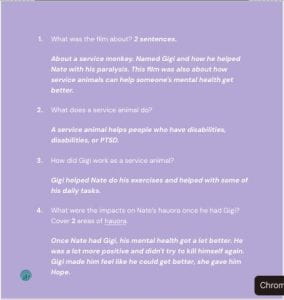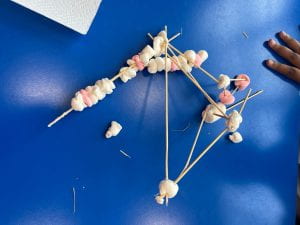| Questions and tasks | Sentence starters (if needed ) | Evidence |
| 1. Introduction: Write the sentence starter out and finish it or write your own introduction about this unit. | In Health, we have been learning about service and therapy animals. We have learned how service animals can be really helpful in times of need. We have also learned what types of animals could be service animals and what is needed in a service animal. We have also looked at what conditions would need a service animal. | My screenshot of what I did in Gigi and Nate |
| 2. What is a service and therapy animal? | A service animal is an animal to help you do tasks you normally would be able to do.
A therapy animal helps calm you down when you’re about to have a panic attack, etc. The difference between them is that a service animal is there for you to help you with daily tasks you can’t do in your condition, and a therapy animal is there to calm you down when you are about to relapse or have a panic attack. |
|
| 3. State which conditions are eligible for a service or therapy animal in NZ | There are many conditions that are eligible for a therapy or service animal in NZ such as epilepsy, narcolepsy, diabetes, paralysis, depression, schizophrenia, allergies causing anaphylaxis, Addisonian crisis, and heart conditions. | |
| 4. Describe how service and therapy animals support well being/hauora | A service or therapy animal supports all 4 dimensions of wellbeing hauora for the individual by helping when their owner with daily tasks they can’t do anymore, (taha tinana). It could help them in situations of panic like when you are about to have a panic attack they would help calm you down, (taha hinengaro). If you have a wheelchair, the service animal say it was a dog, it would bark and get people to move out of the way for you to get past, (Taha whanau). If you have paralysis and you used to always read the bible or a book before bed you could get a service animal (preferably a monkey) to help you turn the pages, (taha wairua).
For Excellence- cover all 4 areas of wellbeing/hauora |
|
| 5. List 4 interesting OR new things that you have learned from this unit of work | The 4 most interesting/or new things that I have learned during this unit of work were finding out how service animals helped people, learning about how different service animals and therapy animals are, finding out that many different animals could be service/therapy animals, and learning about what kind of conditions would preferably need a service animal.
For Excellence- explain why you found these 4 things of interest |








